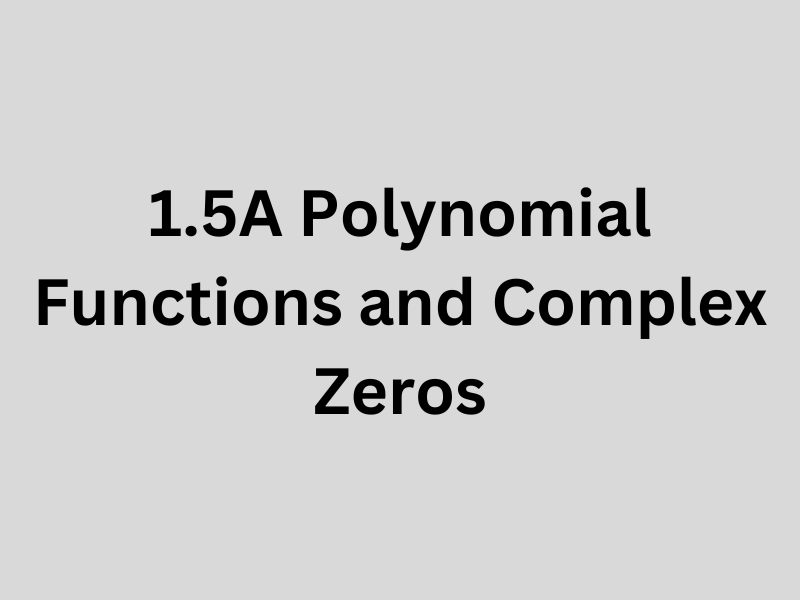Even and Odd Polynomials
Polynomials can be classified as even, odd, or neither, based on their symmetry properties. Even polynomials are symmetric about the y-axis, meaning their graph remains unchanged if x is replaced with -x. Mathematically, a polynomial f(x) is even if f(x) = f(-x) for all x. Odd polynomials exhibit point symmetry about the origin, meaning their graph rotates 180 degrees about the origin without changing. This occurs if f(-x) = -f(x) for all x.
Examples
- Even Polynomial:
f(x) = x^2. This quadratic function is symmetric about the y-axis. - Odd Polynomial:
f(x) = x^3. This cubic function shows point symmetry about the origin. - Even Polynomial:
f(x) = x^4 + x^2. Contains only even powers ofx, showing y-axis symmetry. - Odd Polynomial:
f(x) = x^5 - x^3. Composed of odd powers ofx, exhibiting origin symmetry. - Even Polynomial:
f(x) = 4x^4 - 2x^2 + 1. Remains unchanged ifxis replaced by-x. - Odd Polynomial:
f(x) = -3x^5 + 2x. Changes sign but not absolute value whenxis replaced by-x. - Even Polynomial:
f(x) = 1 + cos(x)^2. Though not a polynomial by strict definition, it illustrates even function behavior with cosines. - Odd Polynomial:
f(x) = sin(x) * x. Also, not a strict polynomial but shows how multiplying an odd function (sin(x)) byxgives an odd function. - Neither Even nor Odd:
f(x) = x^3 + x^2. This polynomial does not exhibit symmetry around the y-axis or origin. - Neither Even nor Odd:
f(x) = x^4 + x. Similarly, lacks the symmetry to be classified as even or odd.
Packet
| Practice Solutions
| Corrective Assignments
| ||||||||
AP Learning Objectives:
1.5.B Determine if a polynomial is even or odd.
Frequently Asked Questions: Even and Odd Polynomials
What does it mean for a polynomial function to be "even" or "odd"?
In mathematics, "even" and "odd" when applied to functions (including polynomial functions) refer to specific symmetry properties:
- An **Even Function** is one where \(f(-x) = f(x)\) for all \(x\) in the domain. The graph of an even function is symmetric with respect to the y-axis.
- An **Odd Function** is one where \(f(-x) = -f(x)\) for all \(x\) in the domain. The graph of an odd function is symmetric with respect to the origin (meaning if you rotate the graph 180 degrees around the origin, it looks the same).
How do I tell if a polynomial is an even or odd function algebraically?
To determine if a polynomial \(f(x)\) is an even or odd function algebraically, you need to evaluate \(f(-x)\) and compare it to \(f(x)\) and \(-f(x)\).
- Substitute \(-x\) for every \(x\) in the polynomial expression \(f(x)\).
- Simplify the expression for \(f(-x)\).
- Compare \(f(-x)\) to the original \(f(x)\):
- If \(f(-x) = f(x)\), the polynomial is an **even function**.
- If \(f(-x) = -f(x)\) (meaning every term in \(f(x)\) has its sign flipped), the polynomial is an **odd function**.
- If neither of these is true, the polynomial is **neither** even nor odd.
What is the difference between an "even or odd polynomial function" and the "degree of a polynomial being even or odd"?
This is a common point of confusion! They are **not the same thing**.
For example:
- An **even or odd polynomial function** refers to the symmetry property \(f(-x) = f(x)\) or \(f(-x) = -f(x)\) as described above. This is determined by *all* the exponents in the polynomial being either all even or all odd.
- The **degree of a polynomial being even or odd** refers only to the highest exponent in the polynomial.
For example:
- \(f(x) = x^3\) is an odd function (all exponents are odd - only \(x^3\) exists). Its degree is 3 (odd). They match.
- \(f(x) = x^2 + 4\) is an even function (exponents are 2 and 0, both even). Its degree is 2 (even). They match.
- \(f(x) = x^3 + x^2\) is neither an even nor an odd function (it has terms with odd (3) and even (2) exponents). Its degree is 3 (odd). The function type and the degree do *not* match.
How does the graph of a polynomial show if it's an even or odd function?
You can visually check the symmetry from the graph:
- If the graph is exactly the same on both sides of the y-axis (it can be folded along the y-axis and match), it represents an **even function**.
- If the graph looks the same after being rotated 180 degrees around the point (0,0) (the origin), it represents an **odd function**.
How does the degree of a polynomial (even or odd) relate to its graph's end behavior?
The highest degree term \(a_n x^n\) determines the graph's end behavior (what happens as \(x\) goes to positive or negative infinity).
- For a polynomial with an **even degree**, the ends of the graph will point in the **same direction** (both up if \(a_n > 0\), both down if \(a_n < 0\)).
- For a polynomial with an **odd degree**, the ends of the graph will point in **opposite directions** (one up and one down).






